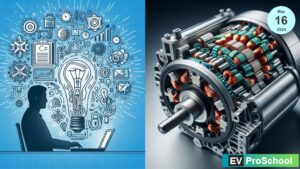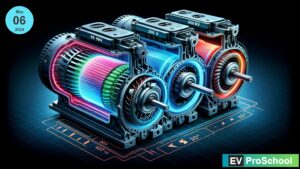Electromagnetic forces within an electric motor, such as those in Permanent Magnet Synchronous Motors (PMSMs) or Induction Motors, can induce vibrations due to the interaction between the magnetic fields of the stator (stationary part) and the rotor (rotating part). Here’s a simplified example to illustrate how these vibrations are induced:
Example: Electromagnetic Vibration in a PMSM Motor
Consider a PMSM motor, which uses permanent magnets on the rotor and electrical windings on the stator. When electrical current flows through the stator windings, it creates a magnetic field that interacts with the magnetic field of the permanent magnets on the rotor. This interaction generates torque, causing the rotor to turn.
However, this interaction can also produce electromagnetic forces that are not uniform across the rotor. For instance:
- Cogging Torque: This is a type of torque ripple caused by the interaction between the permanent magnets on the rotor and the slots of the stator. As the rotor turns, the magnets align and misalign with the stator slots, creating variations in the magnetic attraction. This results in a cogging or jerking motion, which can induce vibrations in the motor structure.
- Torque Ripple: Besides cogging torque, variations in the electromagnetic force can occur due to the design of the motor’s control system or the geometry of the motor itself. These variations lead to torque ripple, a periodic increase and decrease in torque output as the motor rotates. This uneven torque production can cause the motor to vibrate.
Induction of Vibration
When the motor operates, the non-uniform electromagnetic forces (like those causing cogging torque and torque ripple) can induce mechanical vibrations. Here’s how it happens:
- Non-Uniform Forces: As described, the electromagnetic forces acting on the rotor aren’t constant but fluctuate due to the design of the motor and the interaction between the stator and rotor fields.
- Mechanical Response: The motor’s mechanical components (rotor, shaft, bearings) respond to these fluctuating forces. Since the forces are not uniform, they can cause the rotor to oscillate or vibrate as it spins.
- Transmission of Vibration: The vibrations originating from the rotor can transmit through the shaft to the motor housing and eventually to the entire machine or vehicle. Depending on the frequency and amplitude of these vibrations, they can lead to noise, wear, and reduced performance of the motor.
Mitigation Strategies
Engineers use several strategies to mitigate electromagnetic-induced vibrations, including:
- Design Optimization: Refining the motor’s geometry, such as adjusting the number of stator slots or the arrangement of magnets, to minimize cogging torque and torque ripple.
- Advanced Control Techniques: Implementing sophisticated control algorithms, like Field-Oriented Control (FoC), which can precisely regulate the current in the stator windings to reduce torque ripple.
- Damping Mechanisms: Incorporating materials or components that absorb vibrations, reducing their transmission to the motor housing and the surrounding structure.
Understanding and mitigating electromagnetic-induced vibrations is crucial for improving the performance, durability, and acoustic properties of electric motors.



